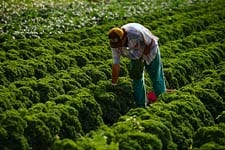Our food is in the path of development
by Jody Aliesan, PCC Farmland Fund President and Operating Officer
This article was originally published in January 2003

Buy local food. Speak up. Support the Farmland Fund.
(January 2003) — Our national food supply is threatened by development. Fully 86 percent of our fruits and vegetables and 63 percent of our dairy products are produced on the edge of urban areas. The problem is wasteful land use. The villain is sprawl.
The United States is losing two acres of farmland every minute, according to a new study by the American Farmland Trust (AFT). The rate of loss was 51 percent faster in the ’90s than in the ’80s. We’re losing the most fertile and productive land most quickly.
Washington State lost nearly 10,000 prime acres a year between 1992 and 1997 at a rate 30 percent faster than during the previous five years. Based on census data and information from the U.S. Department of Agriculture about crops and soil, the AFT study found that more than half of the lost farmland has gone to single houses on 10-acre lots linked by new roads, highways and malls.
“We’re needlessly wasting one of the world’s most important resources” for food security, states AFT, a nonprofit organization based in Washington, D.C. In addition to food production, “well-managed farmland shelters wildlife, supplies scenic open space, and helps filter impurities from our air and water. These working lands keep our taxes down and maintain the legacy of our agricultural heritage. It makes no sense to develop our best land.”
Efforts to change U.S. farm policy resulted in a new farm bill in 2002 that provides about $100 million in matching funds every year to help state and local groups and governments buy easements for permanent protection of farmland. But the vast bulk of the $180 billion federal appropriation continues subsidies to agribusiness production of cotton, rice, wheat, corn and soybeans for export commodity markets.
The new AFT report supports those who have been urging that investing federal money in protection of vulnerable farmland makes more sense than spending it on crop subsidies.
AFT recommends more funding for agricultural easements, expansion of programs that share with farmers the costs of providing environmental benefits, first use of conservation funds in the most valuable, most threatened areas, and strong national standards for development — such as higher-density housing in outer suburban areas rather than ranchettes for the wealthy.
What we can do
- Buy locally produced food — with Community Supported Agriculture (CSA) farm shares, at farmers’ markets, or from retailers like PCC who purchase from local farmers.
- Contact your elected officials, zoning board, planning board, or planning commission. Let them know you support local agriculture and want your farmland protected.
- Live near your workplace, in an already-established community.
- If you own land, protect it from development with a conservation easement.
- Vote for candidates who support farmland preservation.
- Make a contribution to the PCC Farmland Fund.
For more information, read the full report at the American Farmland Trust Web site: www.farmland.org/farmingontheedge/
